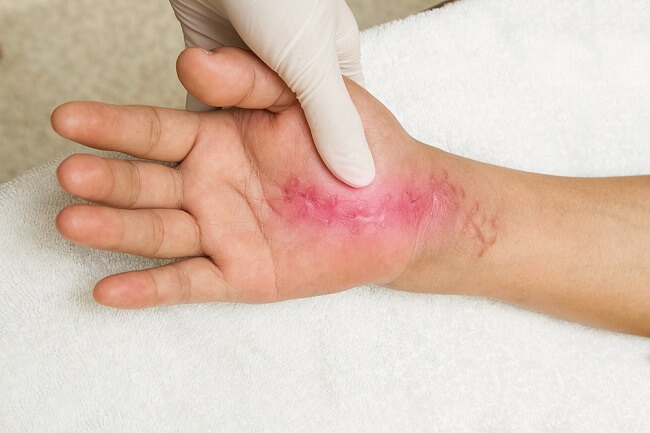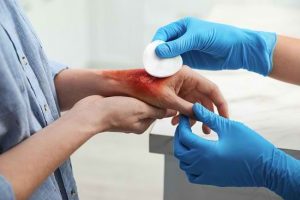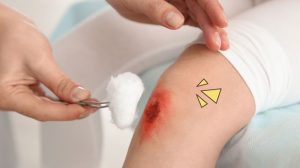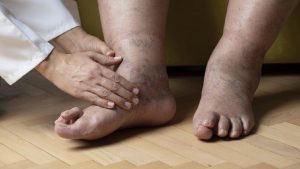Small and minor wounds on the skin usually heal on their own without specific treatment. But larger and more serious wounds require particular treatment. For example, stitching the wound. However, the sutures require treatment to prevent infection and speed up the healing process.
Different Types of Sutures for Wounds
A suture is needed to hold the tissue together as it heals. The goal is to reconnect the exposed skin so that all the tissues can reassemble. Once the skin is closed, the suture will be removed. Suture removal has a procedure that must be followed for the wound to heal optimally.
There are several types of wound sutures commonly used by doctors, namely:
Simple interrupted suture: This is the most common type of suture. Suturing is done by inserting the needle perpendicular to the outermost layer of skin. In this way, the sutures can reach deeper tissues, thus accelerating wound healing.
Continuous suture: this type of suture is performed without interruption. The doctor stitches the wound sequentially without cutting the sutures. After the entire wound is covered, the thread is tied.
Running locked suture: a simple continuous suture can be locked or left unlocked. With the locked technique, the doctor will lock the stitch by inserting the needle through the thread each time a suture is made.
Vertical mattress suture: this is a variant of the simple interrupted suture. The needle is inserted into the wound edge and out of the skin in the same position at the opposite end of the wound edge. The needle is then reinserted into the second side of the wound and exits the skin in the same position on the first side of the wound. The suture is then secured with a knot.
Horizontal mattress suture: the needle is inserted 5-10 mm from the edge of the wound and exits from the opposite side of the wound. The needle is then reinserted into the second side of the wound and removed from the skin in the same position on the first side of the wound. A knot is made to secure the suture.
Running subcuticular suture: it is similar to horizontal mattress suture, but is buried in the skin in a zigzag pattern so the stitches are not visible.
Different Types of Needles and Threads
Like sewing clothes, doctors need a needle and thread to make a suture. However, medical needles and threads are different from regular one. Generally, medical needles are made of stainless steel. Types of needles can be classified based on the eye, body, and tip. For example:
Needle eye
- Traumatic: there is a thread hole in the eye of the needle. It can be used several times. The puncture hole is bigger.
- Atraumatic: the needle is connected to the wound suture and the puncture hole is smaller. But it can only be used once. After the connected thread runs out, the needle is discarded.
Needle body
- 1/2
- 3/8
- 1/4
- 5/8
- J-shaped
- Curved compound
- 1/2 curved
- Straight
Needle tip
- Conventional cut: it has three points, the third is inside the needle.
- Conventional bevel cut: it is a developed conventional cut, recommended for the closure of lacerations.
- Reverse cut: the third point is in a convex groove on the outside of the needle. Generally for tissue that is more difficult to penetrate with conventional needles.
- Lateral cut (spatula): the tip is trapezoidal, intended for minor surgery.
- Sharp point: this sharp needle can penetrate and go through the tissue by stretching without cutting the tissue.
- Precision tip: this needle is triangular
- Blunt tip: round, blunt tip needle, used for dissection of delicate tissue
Meanwhile, wound sutures can be distinguished based on their structure, absorbency, and material. Depending on the structure, there are monofilament and multifilament suture. Monofilament suture is made up of a single strand, while multifilament suture is composed of a braid of multiple strands. Monofilament suture penetrates the skin more easily, but is less resistant. Multifilament suture is used with antibiotics to prevent inflammation.
Depending on absorbency, there are absorbable and non-absorbable suture. Non-absorbable suture must be removed after a few days, but the results are more aesthetic. Meanwhile, absorbable suture can be absorbed by the skin. However, the use of absorbable suture increases the risk of inflammation and scarring.
Depending on the material, there are natural and synthetic wound sutures. The natural materials used include collagen or animal tissues that have been purified. Synthetic materials for wound sutures include nylon or polyester.
What to Watch Out for Wound Stitches
Wound sutures require adequate care to avoid infection and ensure wound healing proceeds according to medical estimates. If an infection occurs, the wound will be difficult to heal and can even get worse. Signs of infection to watch out for include:
- The suture area is red and swollen
- Pain intensity increases
- Appears pus or bleeding from the wound site
- Bad odor comes out from the wound site
- Wounds don’t close
- Fever 48 hours after getting stitches
What Tools Are Required for Caring and Removing Sutures?
Depending on the type of wound and sutures, you can care for the sutures by yourself at home, including removing them after the wound is closed. You will need tools such as gauze and bandages, plasters, antibiotic ointment, and disposable medical gloves. As for removing the sutures, you will need tweezers, a clean cloth, and small scissors. You can buy these medical tools at pharmacies. To determine what equipment is needed, you can ask the doctor or nurse who provided the stitches. Some types of wounds don’t require antibiotic ointment.
How to Care for and to Remove Sutures at Home?
Usually, the doctor or nurse will give instructions on how to care for and how to remove sutures at home. Steps to care for sutures at home include:
- Wash your hands with soap and running water, then dry your hands to avoid bacterial infections.
- Remove the dressing slowly and gradually, not suddenly.
- Clean the sutures with soap and running water. Gently rub sutures.
- Dry the sutures with a clean, dry towel or cloth. You can also let the sutures dry by themselves. The sutures should be completely dry.
- If prescribed by the doctor, apply antibiotic ointment to the sutures.
- Apply dressing after finishing all above processes.
As for suture removal, keep in mind that not all types of sutures can be removed by ourselves. Some of them can only be opened by professional medical personnel for the patient’s own safety. Also, make sure the sutures are completely dry and can be safely removed according to the doctor’s instructions.
First of all, make sure your hands and sutures are clean. After that, sterilize the scissors and tweezers that will be used to open the sutures by placing them in boiling water for at least 20 minutes. Find a comfortable, bright place where the sutures can be seen clearly.
Generally, the steps for removing sutures at home include:
- Hold the knot at the end of the stitches with tweezers, then pull it out a little at a time slowly
- Take the scissors, then cut the knot
- Pull a stitch slowly after cutting the knot
- Repeat the above process until all stitches are removed one by one
- Count the stitches that have been removed, make sure all the stitches are removed completely
When Is It Necessary to Go to the Doctor or Hospital to Remove Sutures?
The doctor will tell you when the sutures can be removed, including whether they can be removed at home. Doctors usually recommend the sutures to be removed in a hospital for safety reasons. The doctors will first check the condition of the sutures to ensure that they can be removed safely.
For doctor visit, doctor tele-consultations and home nursing services, please contact Kavacare Support on Whatsapp 0811 1446 777.



